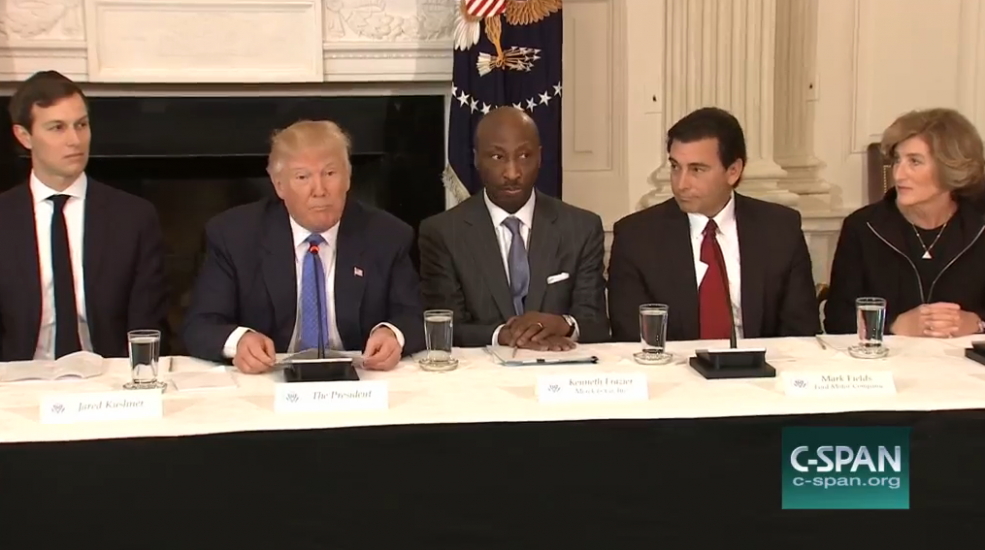President Donald Trump met with 24 manufacturing CEOs Thursday morning for a meeting that Press Secretary Sean Spicer said Wednesday will cover, “deregulation, tax and trade, training and the workforce of the future and infrastructure.”
Among those in attendance included leaders from General Electric, Dell, 3M, Ford Motor Co., Johnson & Johnson, Whirlpool, Lockheed Martin, International Paper, Campbell Soup, General Dynamics, Dow Chemical Co., Caterpillar, and United Technologies.
PREVIOUS STORY: President Trump Kicks Off Week of “Heavy Focus on Jobs”
Vice President Mike Pence also sat in on the meeting along with some Cabinet members as they prepared to discuss various policy ideas. Unfortunately, the media was ushered out of the meeting right after introductions, so the public was not able to listen in on what was discussed.
What we do know was what was said and, more importantly, not said during President Trump’s introduction and statement to the media and CEOs before the doors closed.
In his opening, Trump noted the great strides his administration has made so far in his first 100 days in office saying, “People are saying how they’ve never seen so much happen in 30 days of a presidency, we’ve delivered on a lot.”
MORE: Is Trump Getting the Job Done on Jobs?
He then criticized the damaging effect NAFTA and China’s addition to the World Trade Organization have had on American manufacturing jobs.
In order to remedy this problem, Trump again noted that his policies regarding regulation reform, tax reform and trade will be the solutions that will “return significant manufacturing jobs to our country,” however, there was no mention of addressing the issue of automation or inadequate education — highlighted by the absence of Education Secretary Betsy DeVos from the meeting.
MORE: Building the New American Economy: Trump vs. Sachs
Instead of DeVos being a part of the working group titled, “The Workforce of the Future,” Trump tapped his daughter, Ivanka, along with Reed Cordish, assistant to the president for intragovernmental and technology initiatives, Commerce Secretary Wilbur Ross and Small Business Administration head Linda McMahon.
While Trump continues to emphasize the struggling state of the manufacturing industry, in truth, manufacturing output in the U.S. has been on an upswing over the past decade and the latest numbers show the unemployment rate in the manufacturing sector is actually lower than the national average at 4.2%.
The main reason jobs have been lost on the factory floors is due to automation and robots replacing workers. However, as automation replaces low-skilled jobs, in turn, it is creating new high-skilled ones. So in addition to re-training our current workforce, our education system needs to be restructured in a way that properly prepares students for the future.
This was a sentiment it appears many of the CEOs in the room felt was important and brought up during today’s meeting.
Axios spoke with Keith Leimbach, CEO of LiveOps, who participated in “The Workforce of the Future” group.
He told the media site, the CEOs talked a lot about job training:
“When we think of manufacturing, most people think of smokestacks and guys walking out with coal dust on their faces. But there are some very interesting high-tech, high-skilled jobs today in manufacturing. For example, we heard about a guy who runs a $500 million milling machine that it takes a couple of years to get certified on… There are tons of these jobs available, but there is not currently a way to fill them or fill the pipeline.”
If President Trump wants to tackle jobs in manufacturing and in other sectors, he will need to focus more on addressing the employability gap problem that has led to millions of jobs being left open because of the lack of skilled workers to fill them, in addition to the policies he has made the cornerstone of his campaign and early on in his presidency.
Ways he can do that, which were also reportedly brought up in today’s meeting include “improved access and less stigma to vocational education, plus public-private apprentice programs that borrow from what is seen in many European countries.”
At WorkingNation, we have highlighted some organizations that are helping do those very things. You can read more about the great things they are doing to help this working generation and the generations to come for the future of work here.











